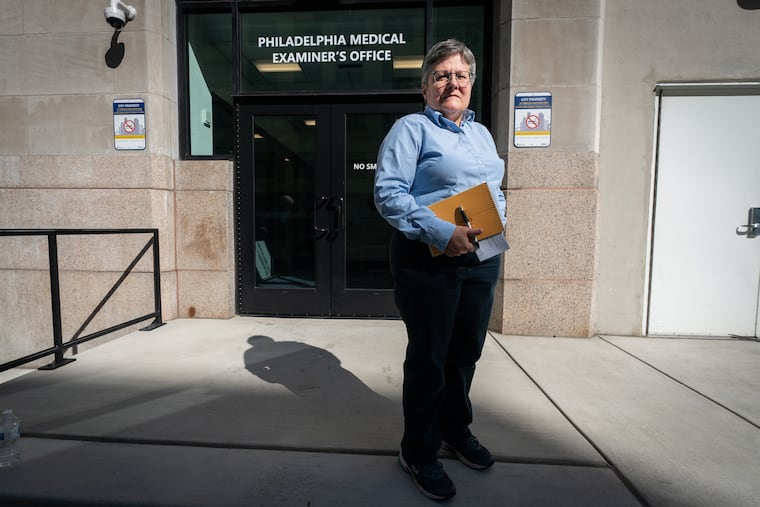Philly’s new chief pathologist contends with understaffing, disorder, and a troubled legacy at Medical Examiner’s Office
A department in need of a shake-up has a new boss.

Soon after starting her job, Philadelphia’s newest chief medical examiner was dismayed to learn some of the city’s dead arrived at her office in the back of a police car.
A victim of a sudden death should be transported by a medical examiner’s staffer, who can bring a different, and important, expertise to a scene that police officers may not have, said Constance DiAngelo, who started at the Philadelphia Medical Examiner’s Office three months ago.
She added it to the list of issues in need of fixing at a city office where missteps can determine whether families get closure after a loved one’s death.
The Medical Examiner’s Office, responsible for establishing cause and manner of death for homicides, overdoses, and other sudden or unexplained deaths, is straining to keep up with record overdose deaths and homicides in the last two years. It is understaffed. Policies aren’t documented. Instead rules are established through a haphazard array of memos and word of mouth. Victims arrive in the back of police cars because there often isn’t anyone to send to the scene. DiAngelo has taken the reins of an office the mayor has said is in need of reform.
“I would like to just have more control over how things happen,” said DiAngelo, who is paid $314,000 annually. That’s better pay than the mayor gets and slightly more than the police chief’s salary, though less than the city’s school superintendent.
The office was also recently castigated for mishandling victims’ remains from the 1985 MOVE bombing, when police set off an explosion that led to the deaths of 11 people and burned dozens of West Philadelphia homes. DiAngelo’s predecessor, Sam Gulino, resigned last year after the city revealed that the office had kept a box of human remains from the bombing in a storage closet for decades without informing victims’ families, and nearly destroyed them in secret.
“If you’re not aware of history it will repeat itself,” DiAngelo said. “I would never do the things that happened 35 years ago. As long as I’m here, it will not happen.”
A native of York, DiAngelo did a fellowship in Philadelphia more than 20 years ago but has spent much of her career as a deputy chief medical examiner in the Washington, D.C., area. She has a quiet, measured authority, though she smiled when asked about the Hogwarts lanyard around her neck and recounted reading Harry Potter books to her three now-grown children.
A fascination with forensic pathology drew her to medical school.
“We’re solving a puzzle,” she said. “We are helping families. We’re providing answers for why their loved ones died.”
Gregory McDonald, her attending physician during her Philadelphia fellowship and chairman of the department of forensic medicine and pathology at the Philadelphia College of Osteopathic Medicine, said her experience and history in Philadelphia would help in this “difficult” new job.
“She comes from a background of knowing the challenges in a city like Philadelphia,” he said.
Seeking accreditation
So far, DiAngelo has spent more time at a desk than at the autopsy table. Her priority is to ready the office for accreditation, earned when an office’s training, equipment, and physical location meet professional standards. About 4% of the nation’s 2,500 offices were accredited as of 2016, though Philadelphia is one of the few among the country’s top 10 biggest cities without an accredited medical examiner’s office.
The process could take three to five years, she said, and she anticipates staying in the job at least long enough to see it through.
» READ MORE: Philly’s medical examiner’s office is understaffed and struggling to investigate deaths. Fixing it might take years.
The mishandling of the MOVE remains prompted an independent audit of the office. Released this summer, it criticized the office for not being accredited.
“There needs to be some serious attention on this office and what it does,” said Keir Bradford-Grey, a partner at Montgomery McCracken Walker & Rhoads and an author of the report.
Reaching accreditation requires DiAngelo to assemble dozens of manuals that detail how the office should operate, down to specifics of how to properly clean floors and surgical instruments. Some may be finished by the end of the year.
The report released this summer noted the office sends an investigator to just 40% of the sudden or unnatural deaths it investigates, a result of the understaffing. It also found the office’s forensic pathologists were likely examining too many patients to meet accreditation standards.
Hiring is difficult, DiAngelo said, because offices in neighboring counties pay better.
Philadelphia Health Commissioner Cheryl Bettigole has said it probably isn’t necessary for an investigator to visit every homicide scene, but the medical examiner should ensure one is present at all police-involved deaths. DiAngelo also wants to have enough people to send an investigator to the scene of child deaths and apparent natural deaths and drug-related deaths in which the victim has decomposed. Giving staff time to visit scenes in the days after a death can also be important in investigations of infant deaths or when there is uncertainty whether a death is accidental or a suicide.
DiAngelo is establishing internships and recruiting with Philadelphia College of Osteopathic Medicine and several Virginia colleges to create a hiring pipeline.
“If we can pay a competitive salary,” she said, “I think we certainly have the casework type that many investigators would find challenging and exciting to be a part of.”
This story has been updated to correct Gregory McDonald’s first name.